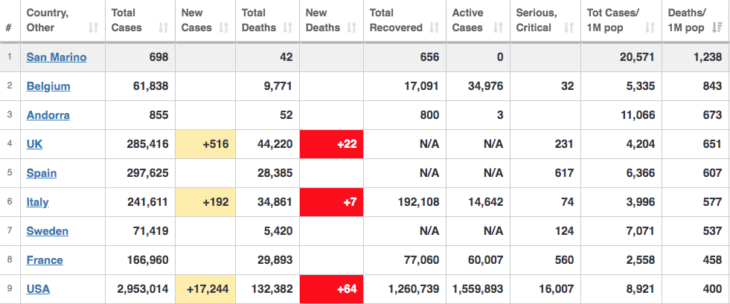
Tyler Cowen linked to a tweet that mentioned the fact that:
On a per-capita basis, of the European majors only Germany has done better than the US in death rate
The “European majors” include Spain with 46.8 million people but not Poland with 37.8 million. So the cutoff seems to be a rather arbitrary 40 million people.
Let’s start with a list compiled by Worldometer, which includes 215 “countries” (actually entities.)

The US shows up 9th in Covid-19 deaths per capita. Only 8 of 215 countries are worse. But obviously that’s just a first pass, and is just as arbitrary as the tweet. So I’ll look at the data from a variety of perspectives, and reach a VERY tentative conclusion.
1. Many of the countries are tiny. If we exclude places with fewer than 5 million people (roughly the population of Denmark, Norway, Finland or New Zealand), then we have 122 countries, 6 of which did worse than the US. That doesn’t look good for the US.
2. There are likely some other countries that are actually doing worse than us, but have underreported deaths. Mexico is an example. On the other hand, for various reasons I believe the US would be fairly near the top in death rates with an accurate list. First, most countries have death rates far below the US level. Second, most countries don’t underreport deaths as much as Mexico. And third, even the US likely underreports Covid-19 deaths, relative to places like Belgium. I believe we’d probably still be top 15 on an accurate list.
3. It’s also a dynamic process. We are gradually catching up to places like France, but others below us (like Brazil) are gradually catching up to us.
4. It’s not clear why the “European majors” are the right comparison group for the US. Yes, we are a big country, but places like The Netherlands are far, far more densely populated than the US. Parts of the US that have closer to Western European population density (say Massachusetts or New Jersey) have outcomes that are much worse than most of Europe. Of course there are also parts of Europe like Milan and Madrid that are far worse than the European average. So you have a real apples and oranges problem in deciding how to compare.
5. It’s not clear why a place like Spain is a better comparison to the US than Japan, Australia or Canada. If race/culture is somehow the issue, then Canada and Australia might be best. Some people point out that the US isn’t doing much different from Canada, if you exclude the northeastern US. But if you remove Quebec, then the rest of Canada is doing far better than the US outside the Northeast. Again, the apples and oranges comparisons are tricky. What is the right set of countries or regions? Is climate decisive? Density? Exposure to BCG vaccines? Percent elderly? Without a model, it’s hard to know how the US is doing. I live in suburban Orange County, and feel that it’s much easier for me to avoid the virus than if I lived in a dense European city.
Finally, it’s important to be consistent in your approach. You do NOT want to make both of these two arguments:
1. The early failures in places like Sweden and New York were not costly, as herd immunity is the inevitable endgame everywhere.
2. Outside the Northeast, things aren’t so bad. Thus the US isn’t doing that bad.
If the first argument is true, then the second argument is kind of pointless. If herd immunity is the endgame, then all of the US will eventually be hammered as hard as the Northeast. (I don’t expect that to happen, BTW.)
This issue inevitably becomes politicized, and I see people on both sides who cherry pick data and arguments, and ignore data points that conflict with their preferred analysis.
A year from now we’ll have a much better idea of how the US did. If by the time that an effective vaccine or drug comes along the US ends up with 160,000 dead, then the implications for our policy response will be vastly different from if we end up with 500,000 dead. That’s because if we end up with 160,000 dead then we’ll know that herd immunity was not the endgame, and in that case the high death toll in April and May will seem like a very costly policy error. If we end up with 500,000 dead then it will seem possible that the early mistakes were not that consequential; herd immunity was the only practical endgame. (I say “possible” because even then you’d need to look at the endgame in places like Australia.)
In my view, both the US and 4 of 5 European majors had a poor response to the crisis. But I understand how people would disagree with me—it’s hard to prove either way.
PS. This post is not primarily about President Trump. I am describing the response of 330 million American people to the virus, including me, the FDA, the CDC, Trump, Governor Cuomo, and people who refuse to wear masks in crowded stores.

READER COMMENTS
Alan Goldhammer
Jul 5 2020 at 7:59pm
Scott – I have a number of retired public health and pharma people on my newsletter distribution list and we exchange emails regularly. This afternoon we were discussing herd immunity and Case Report Fatality Ratios (CRF). We have very poor numbers to be able to calculate a true CRF. It is thought that the new SARS-CoV-2 variant is more infectious but is it more lethal? We don’t know right now. I am fond of noting that with respect to COVID-19 we are caught in the Rumsfeld Paradigm. Too many unknowns in almost every area.
You can do the simple math on a herd immunity approach as follows: Say the CRF does go down to 0.5% which is midway in my guesstimate. In the absence of a vaccine, we will need to reach the herd immunity point which is unknowable right now. To make the math easy, assume it to be 60% of the population getting infected and recovering. That is 198 M people and we are no where close to that. If you assume my CFR, total mortality ends up at 990 K deaths, totally unacceptable which is why we need to be doing so much more.
The public health failure is immense and needless.
Alan Goldhammer
Jul 5 2020 at 8:02pm
I forgot to note that all the past 15 weeks of newsletters are archived HERE. There is an email link if anyone wants to get the daily email (it’s free!!)
Thomas Hutcheson
Jul 6 2020 at 10:11am
But the failures are that we have done both too much — closing down activities by class of activity rather than regulate activity to reduce transmission and too little — massive testing of asymptomatic people and their contacts to isolate only those who are infected and better public compliance with social distancing/mask wearing recommendations/regulations.
How could we have fallen so exquisitely between two stools?
derek
Jul 7 2020 at 9:09am
Mortality for the original covid seems like it is about 0.5% (much much higher for elderly), so I would say that a 0.5% assumption for a new, less fatal strain seems overly pessimistic.
But this all raises a question of how many deaths would be an okay number? 300-400k? Less than 200k?
Mark Z
Jul 5 2020 at 11:21pm
Maybe the sheer geographical heterogeneity complicates things a bit for the US (especially in comparison to any individual European country). The surge in the US right now isn’t entirely a ‘second wave.’ Much of it is more or less the first wave for parts of the country that were spared the worst of it first time around, while the worst hit part of the US is still seeing decline (though of course California is seeing more cases and was affected badly the first time, so that may safely be called a second wave). Inasmuch as we’re seeing sequential outbreaks with different epicenters, it may mean both that the US is not doing as poorly right now as aggregate number suggest (I’d find it more concerning if places where it was the worst in April were flaring up again than seeing ‘virgin populations’ being hit for the first time; the former would seem more ominous about our ability to control it in the long term) and that the US was doing far worse in April than the numbers indicated then, because we were doing that bad despite the fact that much of the country was geographically insulated from the most affected population centers.
Basically, we should’ve expected to see lagging phases of the epidemic, and that to do as well as, say, France, in the long run, we had to do better than France early on, expecting that while all of France was experiencing the worst of it all at once, much of the US was going to lag significantly behind the first wave epicenters like New York and Washington. If any of this is true, I guess we’d expect other expansive countries like Canada, Russia, and India to see a slower decline due to regional surges far away from the original epicenters as well. I don’t think that’s happening in Canada, don’t know about India or Russia.
Anonymous
Jul 6 2020 at 4:57pm
California was not hit hard initially. Indeed, they are still well below the U.S. average in cases and death per capita. Their daily case count has been pretty much a continuously growing straight line. Contrast with a place like Louisiana which has truly had two waves.
Shane L
Jul 6 2020 at 4:12am
Simply use the Our World in Data site to compare the United States with, say, the European Union.
1) The EU suffered steep increases of Covid-19 deaths earlier than the US. On March 30th, the EU had a death rate of 51.47 per million, compared with just 7.58 per million in the US. Throughout March, the EU had a death rate multiples higher than the US. Therefore, the US had the advantage of a head start.
2) That head start was squandered. By May, the EU’s death rates were flattening, but in the US they continued to rise. By July 5th, the US had a death rate of 391.77, compared with 300.33.
3) If you select the “new per day” option, see that both the US and EU are experiencing considerable decreases in death rates per day, but since mid-April, the US has generally had the higher rates. On July 5th, the US was 0.73 per million, compared with 0.15 per million in the EU.
The world is complicated and there are probably multiple reasons for this. Perhaps it was easier for EU member states to seal their borders than American states, for example. I suspect the extraordinary mixed messages coming from the American President cannot have helped, though.
TMC
Jul 6 2020 at 1:11pm
To back up your position that we can’t judge yet: DNA Inherited From Neanderthals May Increase Risk of Covid-19 https://www.nytimes.com/2020/07/04/health/coronavirus-neanderthals.html
We still have no idea exactly why any country got hit as hard, or not, as they did.
E. Harding
Jul 7 2020 at 3:09pm
The correct comparison isn’t the U.S. v. European majors, it’s U.S.+European majors v. Thailand, Malaysia, Hong Kong, Singapore, Tunisia, and Australia.
Comments are closed.